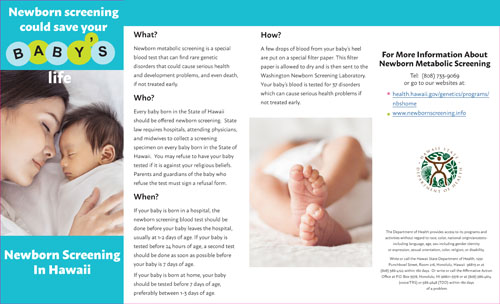Newborn Screening for Cystic Fibrosis (CF)

The Hawaiʻi Newborn Metabolic Screening Program Advisory Committee recommended the addition of CF to the state newborn screening (NBS) panel. CF was added to the NBS panel on September 1, 2007.
- More information about Cystic Fibrosis
Implications for Your Practice
- Cystic fibrosis (CF) was added to the state newborn screening (NBS) panel on September 1, 2007.
- NBS for CF is a screening test. DO NOT base a diagnosis of CF on one or two positive NBS results. Diagnosis of CF needs to be confirmed with additional diagnostic tests and genetic evaluation. The Hawaiʻi Newborn Screening Program can assist you with the coordination and costs of the follow-up to confirm a diagnosis of CF in the newborn.
- Health care providers should not begin medical intervention until confirmatory testing is completed. About one-third of children with positive screening results are confirmed to have CF.
- Families and infants diagnosed with CF should receive genetic evaluation and counseling, and ongoing care provided by a pediatric pulmonologist and gastroenterologist.
- NBS does not detect all cases of CF in newborns. Up to 5% of CF cases may not be detected so all symptomatic children for CF should receive evaluation regardless of their NBS test result.
Rationale
Cystic fibrosis occurs once in every 3,700 births in the United States and is one of the most common genetic disorders among Caucasians. CF is a severe multi-organ disease, primarily affecting the lungs and pancreas.
The frequency of CF varies by race and ethnicity
(see table below):
| Group | CF Cases/Live Births |
|---|---|
| Caucasian | 1 in 2,500 – 3,000 |
| Hispanic | 1 in 4,000 – 10,000 |
| African American | 1 in 15,000 – 20,000 |
| Asian | 1 in 30,000 |
It is caused by a defect in the cystic fibrosis transmembrane regulator (CFTR) gene, which encodes a protein that regulates salt transport across cell membranes. This defect leads to excessively viscous secretions that cause blocked glands, chronic respiratory obstruction, and infection. Death from pulmonary infections and respiratory failure may occur. Although there are over 1,000 different mutations of the CFTR gene, approximately 70% of the CF cases in the U.S. are caused by ΔF508 mutation; while the remaining 30% of CF cases can result from any of the 1000+ mutations.
The average age of diagnosis in the U.S. is 14 months without newborn screening. With newborn screening, diagnosis can be made as early as two weeks after birth. Children diagnosed earlier through newborn screening tend to have improved nutritional status and cognitive development. Future innovations in clinical management may significantly improve survival and further increase the benefits of newborn screening.
Screening Methodology
Hawaiʻi follows the testing algorithm used by the Washington State Department of Health, Hawaii’s contracted NBS laboratory. The algorithm involves initially testing immunoreactive trypsinogen (IRT) levels on the blood spot specimen, routinely collected ≥ 24 hours after birth. Trypsinogen is the inactive precursor of pancreatic trypsin, and is elevated in infants with CF.
If the initial IRT is positive, a repeat IRT test will be requested. Newborns with a second positive IRT test will then have a 2nd tier test, which is a genotype panel for CF. The panel looks for the 23 most common mutations found in the cystic fibrosis gene. Newborns who have two positive IRT tests and are found to have 1 or 2 mutations in the cystic fibrosis gene will receive genetic evaluation and genetic counseling; some infants with only 1 mutation found will need further confirmatory testing.
NOTE:
This testing algorithm does identify babies who are carriers of CF.
Questions
For additional information & questions, please contact:
Dana Mulcahy, MSN, RN | NIS
Newborn Metabolic Screening Program Coordinator
741 Sunset Avenue
Honolulu, HI 96816
Ph: (808) 733-9069
Fax: (808) 733-9071
[email protected]
